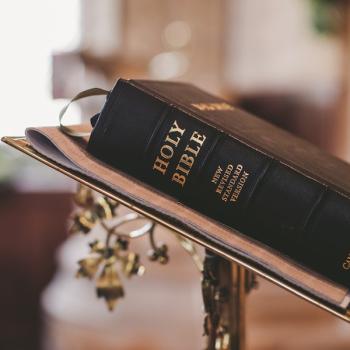
I can’t help but laugh a bit when I hear liturgists and other Catholics speak of “versus populum.” Of course, in Latin it just means “having been turned to the people,” but in English it has an adversative sense; it makes me think of a priest confronting the people, Eucharist held aloft, prepared to fight.
The meaning of the word itself (versus) implies a change in previous practice; it implies that initially the priest ought to be facing somewhere or something else—in the case of the liturgy: ad orientem (toward the east). In other words, the very use of a participle (versus) implies a change of position, a difference from normative practice—a normative practice located in the preposition “ad.”
The relevance of all this is obvious: Cardinal Sarah’s recent suggestions regarding celebrating the Mass ad orientem (a round-up of articles on the issue can be found here). For many, the swift and negative responses by Cardinal Nichols and the Vatican reinforce a narrative of wayward shepherds devoted to destroying tradition. Even an otherwise enlightening piece on the topic can’t help but take a few uncharitable swipes:
It is very instructive indeed to watch people burst out of the closet in the Latin Church to announce their inner struggles with liturgical orientation, and to denounce others for insufficient sensitivity to their occidental proclivities and positions. It is also a bit rich to watch the alacrity with which Cardinal Sarah’s comments about Latin liturgical posture have been slapped down by an undisciplined papacy that has done much damage with off-the-cuff comments and other utterances of dubious authority and torturous prolixity. The fact that the cardinal’s comments have been attacked repeatedly by people huddling in the papal petticoats tells us much about them but almost nothing about the issue to hand.
This misunderstands the response. From what I’ve seen those attached to the reform have two primary issues with ad orientem worship (and neither is some ultra-loyalty to Pope Francis—a strange charge people keep repeating): loss of participation, and loss of ecclesial reform (re-centralization).
The first concern elicits a lot of responses: liturgy is not about participation, one may participate in many ways, not just by seeing a priest, and so forth. The issue is a bit more complicated—liturgy does ask both for attention and reverence. The Byzantine Divine Liturgy of St. John Chrysostom (used by the Orthodox and Byzantine Catholics) is, for example, both ad orientem and highly participatory (one may see a Ruthenian example here). There is almost never silence during the Divine Liturgy, a notable difference with the Mass.
The Latin tradition is a bit different. Both in the Extraordinary and Ordinary Forms, it does include (at least by comparison to its Eastern cousin) a good deal of silence (I would argue that the lack of chanting in most Ordinary Form Masses does not help either). Hence the old complaints about the old days before Vatican II, when everyone and their grandmother sat praying the rosary all through the liturgy, almost indifferent to the goings-on near the altar (at least until the consecration).
One must strike a balance between the engaging nature of a liturgy and its reverential one. This is important. Most Ordinary Form liturgies, however, clearly err on the side of the former, and sometimes err in doing so.
There is therefore some reason to fear that the Roman forms of the liturgy can veer into such alienating territory. In this sense, those reticent about the switch have a point. There are, however, much better ways to encourage participation, which are never to the detriment of reverence (better music, more priestly chanting, encouraging of personal devotions immediately surrounding the liturgy).
The second concern is dealt with very well in the piece I quoted above. Again:
There are many critics of the liturgical reform who have no desire to subject the Church to any kind of yet more centralized ecclesiology supposedly attributed to the pre-Vatican II era but actually much more in evidence since then. I am myself—and can easily think of many others—one such critic: I think the liturgical reforms were good in some ways, but (as Cardinal Ratzinger, inter alia, has also said), enormously damaging in others. At the same time, I salute—and have said so at length elsewhere (see my essay in The Reception of Vatican II, forthcoming from Oxford University Press)—the ecclesiological and ecumenical advances of the council. Indeed, if anything, I join Faggioli in fervently wishing for the ecclesiological and ecumenical work of the council to be yet more fully and widely implemented, especially with regard to the papacy (see my book Orthodoxy and the Roman Papacy).
Let me tell you as someone practicing in the Ruthenian Church: Byzantines do not miss the days of the extremely-centralized Church—the days of Bishop Ireland and Latinization. I see no reason to associate centralization with ad orientem. It’s true that there is a historical connection between those most vocally clamoring for the return of this liturgical posture and what I have termed “rigid traditionalism” (a great fear for Byzantines), but a connection is not an identification. For example, I love Robert Cardinal Sarah and appreciate his voice within the contemporary Church, even if some of—what I often see as—our most vicious and uncharitable believers also love him. One may like both ad orientem and, say, liberation theology, or believe in the power and authority of Communion on the tongue (while not enforcing it upon others) and love Dorothy Day. Let your ideological boxes be broken.
In sum, I see little reason for the concern among so many, for such fears about the future of the Church if ad orientem is reintroduced on a larger scale. There might be reasons to blend the ad and the versus, especially as a compromise in these uncertain times (rampant and often uncharitable assaults on Pope Francis, defensive posturing among “liberals” following the last two pontificates, etc.), but the authority of the ancient way is hard to question. Vatican II speaks of reform, and reform we ought, but, at this point, the reform of the reform (up to a point) may be the surest path.
I’ll leave you with the words of Fr. Mark Drew:
Perhaps what is most at stake here is a difference in views concerning the nature of the Eucharist celebrations as a whole, and the role of the priest within it. An elderly priest once said to me: “When I invite you to a meal, I don’t turn my back on you.” In this view, the Eucharist is primarily a meal, its focus is first and foremost the assembly. God is immanent (that is, present among his people) and the role of the celebrant is to represent Christ as host to the disciples. When priest and people are together facing east (or the apse as the symbolic east, since unfortunately many modern churches are not orientated) then the Mass appears as primarily a sacrifice, the focus is the transcendent God, and the priest is seen as leading the people in prayer, like Christ the Good Shepherd. Which vision is correct? Both, of course. The Mass is both a meal and a sacrifice. If we forget that it is a meal, we misunderstand what kind of sacrifice it is. If we forget that it is a sacrifice, we fail to see that it is a sacrificial banquet. The biblical God is both immanent and transcendent. If we belittle his majesty we diminish ourselves. If we forget that he stoops down from the heights to save us, we effectively make the Incarnation irrelevant. […] I believe that the best way to clearly show these complementary truths, other things being equal, is for the celebrant to face the people for the Liturgy of the Word, for the Communion and dismissal, and for priest and people to face outwards together for the Eucharistic Prayer.













